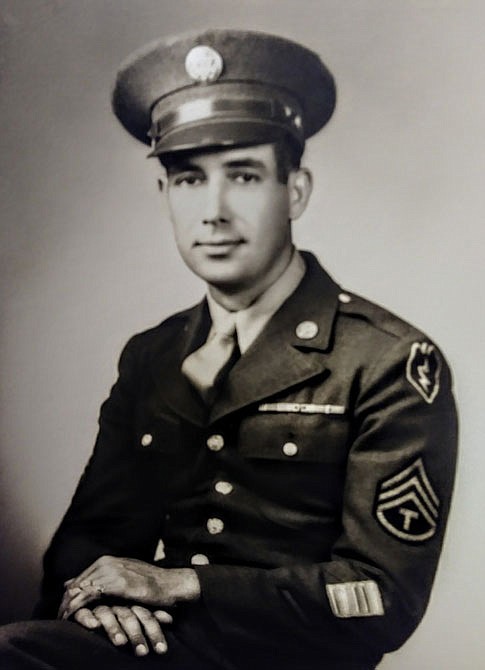On Oct. 16, 1940, while living in Lohman, a 30-year-old Elbert Roy Payne abided by the mandate of the Selective Training and Service Act and registered for the military draft.
Less than four months later, he reported to nearby Jefferson City "for physical examination by an examining board of the armed forces for final determination of your military fitness."
The second oldest of the veteran's four children, Gary Payne, said, "We know very little about his military service. We knew he served in several major campaigns in the Pacific, and he occasionally talked about it, but never provided any great detail about where he was and what he did," he added.
Inducted into the U.S. Army at Jefferson Barracks in St. Louis on March 2, 1942, Payne remained at the post for the next several weeks to complete his basic training. On May 22, 1942, he boarded a troop ship to begin a journey that would span nearly three years of overseas service and introduce him to the woman that would become his wife.
Upon his arrival on the island of Oahu, the 31-year-old soldier was assigned to the Medical Detachment of the 35th Infantry Regiment under the 25th Infantry Division. While in Hawaii, he received several weeks of instruction in a specialty for which he previously had no experience.
As his Army Separation Qualification Record indicates, Payne was trained as a "medical aidman" and learned to serve in an aid station, dressing wounds, administering plasma and providing first aid in combat.
Shortly after completing jungle warfare and amphibious training at nearby Schofield Barracks, "the 35th Infantry departed Oahu on 25 November (1942), arriving at Guadalcanal on 17 December 1942," reported a history compiled by the 25th Infantry Division Association.
The division spent the next several months assaulting and securing areas of the island once held by Japanese forces, earning a Presidential Unit Citation for their valorous actions. During the campaign, Payne provided first aid for wounded soldiers while attached to a rifle company within the division.
"The one thing I remember him saying about his time on Guadalcanal was they were always soaking wet - it was hot, humid, and there were huge mosquitoes and jungle rot to contend with," Gary Payne said.
During the summer, the division became part of the drive to remove Japanese forces from the Northern Solomons, with the 35th Infantry given the lead in seizing the island of Vella Lavella in a campaign beginning Aug. 15, 1943. Once successfully completed, the island was turned over to New Zealand forces on Sept. 18, 1943, while Payne and his fellow soldiers were sent back to Guadalcanal a few weeks later.
"While my father was overseas, he was given leave in New Zealand and attended a local dance that was put on for the soldiers there," Gary Payne said. "It was at this dance that he met Bette, a local woman who would later become my mother," he smiled. "They traded letters back and forth until he got back home."
The 25th Infantry Division Association notes the move was made to New Caledonia in February 1944 to conduct additional training exercises. "The training lasted throughout the summer and into late fall," the association said. "Maneuvers and landings were conducted in preparation for the anticipated invasion of the island of Luzon in the Philippines."
Arriving in Lingayen Gulf on Jan. 11, 1945, the 35th Infantry Regiment became part of the amphibious assault landing on Luzon. The next few weeks were spent clearing the central plains region of enemy resistance while Payne assisted the wounded in a battalion aid station.
"There was a time that dad and I were watching a war movie, and I asked him if he wore the Red Cross armband on his uniform since he was a medic," Gary Payne said. "He stated that they didn't wear one because that made them a target for Japanese riflemen."
His son added, "My father also mentioned that there was a time he and his fellow soldiers noticed their rations were disappearing. It wasn't long after that they caught some Japanese soldiers who had built tunnels under palm trees and were sneaking into their camp at night and stealing the food."
On April 20, 1945, after having spent two years and 10 months overseas, Payne was sent back to the United States. He received his discharge at Jefferson Barracks on June 9, 1945, after achieving the rank of Tech 3 and having earned four Bronze Service Stars for his participation in several major campaigns of the war.
Shortly after the war ended, the veteran brought his fiancée from New Zealand to the United States, where the couple were soon married and went on to raise four children. Payne finished a career as a postal clerk in Jefferson City while also operating a farm near Russellville.
The veteran died in 1990 and his wife died 14 years later; both were laid to rest in the cemetery of St. John's Lutheran Church in Stringtown. His son recognizes that buried with his father were scores of military stories that can now only be pieced together through blurred recollection and military records.
"He would have nightmares about his service right up until he passed away," Gary Payne said. "I can remember the times working on the farm years ago when we'd be shoveling wheat into the bin and I'd ask him about his service. He might share a little bit about what happened but never in great detail."
He added, "At the time, I didn't think much about it, but as you get a little older, you want to know more about what your parents went through." Pausing, he concluded, "I know it's too late to be asking questions now, but it's nice to know that there are records that can help show what he did back in the war."
Jeremy P. Amick writes on behalf of the Silver Star Families of America.

